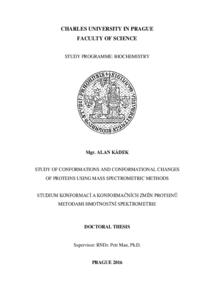Study of conformations and conformational changes of proteins using mass spectrometric methods.
Studium konformací a konformačních změn proteinů metodami hmotnostní spektrometrie.
rigorózní práce (UZNÁNO)

Zobrazit/
Trvalý odkaz
http://hdl.handle.net/20.500.11956/74572Identifikátory
SIS: 185915
Katalog UK: 990021164120106986
Kolekce
- Kvalifikační práce [21483]
Autor
Fakulta / součást
Přírodovědecká fakulta
Obor
Biochemie
Katedra / ústav / klinika
Katedra biochemie
Datum obhajoby
29. 11. 2016
Nakladatel
Univerzita Karlova, Přírodovědecká fakultaJazyk
Angličtina
Známka
Uznáno
Hmotnostně spektrometrické (MS) techniky si v průběhu posledních dvou desetiletí našly své trvalé místo mezi nástroji strukturní biologie. Kromě získání informace o primární sekvenci proteinů jsou stále častěji využívány i pro studium vyšší strukturní organizace bílkovin. Nedosahují sice atomárního prostorového rozlišení, jsou ale naopak prosty řady experimentálních omezení. MS strukturní techniky tak jsou schopny studovat molekuly za nativních podmínek v roztoku, jsou rychlé, mají nízkou spotřebu vzorku a jsou použitelné pro molekuly a jejich komplexy s velmi širokým rozsahem velikostí. Možná nejdůležitější je však jejich schopnost poskytnout informace o konformační dynamice proteinů, které tak mohou doplnit data získaná jinou strukturní technikou s vyšším prostorovým rozlišením v rámci integrativní strukturní biologie. V této disertační práci byla hlavní pozornost věnována technice vodík / deuteriové výměny v kombinaci s hmotnostní spektrometrií (HXMS), která je jednou z nejvíc rozšířených strukturních MS metod. Rekombinantně připravená aspartátová proteasa nepenthesin-1 z láčkovek rodu Nepenthes byla charakterizována, imobilizována a podrobně testována s cílem rozšířit portfolio proteas dostupných pro HXMS experimenty a zvýšit prostorové rozlišení této techniky. Po úspěšné implementaci do HXMS...
Mass spectrometry (MS) techniques have, over the last twenty years, found their stable place in the structural biology toolkit. They are not only employed to provide information on the protein primary sequence, but are increasingly used to probe higher orders of protein structure as well. They may not boast the atomic resolution and the ability to directly provide structural coordinates, but on the other hand suffer from very few experimental limitations as they are able to work under native conditions in solution, provide data fast, with low sample consumption and for proteins and complexes of vastly differing sizes. Perhaps most importantly, they may often be employed to study conformational dynamics of proteins and can thus complement other methods with higher spatial resolution in integrative structural biology approaches. The main focus of this Ph.D. thesis was hydrogen / deuterium exchange coupled to MS (HXMS), which is one of the most widespread structural MS methods. Recombinantly produced aspartic protease nepenthesin-1 from Nepenthes pitcher plants was characterized, immobilized and extensively tested with the intention to expand the portfolio of aspartic proteases in HXMS workflow and to improve the spatial resolution of the technique. Following successful implementation of nepenthesin-1...
